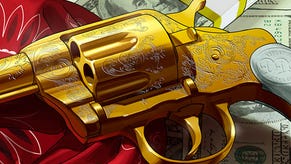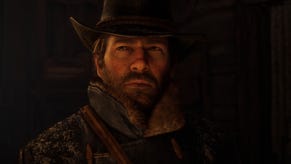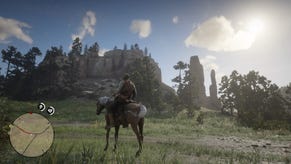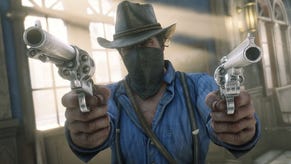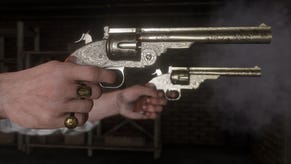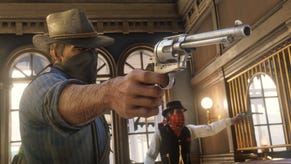Red Dead Redemption's Curious 8-Bit Origin Story
How 2017's Western juggernaut can trace its family history all the way back to the frontier days of 1985.
This article first appeared on USgamer, a partner publication of VG247. Some content, such as this article, has been migrated to VG247 for posterity after USgamer's closure - but it has not been edited or further vetted by the VG247 team.
Today sees what may be the two biggest game teasers of the year duking it out for nerd supremacy: Nintendo's Switch reveal, and Rockstar's Red Dead Redemption 2 debut. (Evidently a lot of marketing people missed the note about E3 being in June.)
The Red Dead series is an interesting case — a franchise that grew in popularity through word of mouth. Unlike its Rockstar cousin Grand Theft Auto, Red Dead has never had a single, explosive moment equivalent to Grand Theft Auto III; Red Dead Redemption became a huge hit over time, as its reputation spread. But before it actually launched, its public reception and perception felt positive but modest, most likely because it was the sequel to an interesting but not particularly huge game from an earlier console generation. Red Dead Redemption 2 looks destined to be a massive success, no question, but the series' path to 2017's inevitable smash release has been a slow one.
In fact, the series almost never happened at all. While Red Dead bears Rockstar's name today, the first entry in the series — Red Dead Revolver — began life at Capcom and ended up being cancelled.
Somehow, Rockstar caught wind of it and snatched up the property, revamping the series from an arcade-style shooter with tracer bullets and a ridiculous heads-up display interface to something more atmospheric.
You can see Rockstar's influence at work in both the game's design and marketing alike by comparing an early E3 2002 demo of the Capcom project....
...to Rockstar's early 2004 trailer for the game:
Of course, it's a little difficult to glean much concrete information about game mechanics and design from Rockstar's version of the trailer. In their usual style (perfected with Grand Theft Auto: Vice City promos a few years prior and still in full effect with today's teaser), it's full of heroic poses against sunsets and long, atmospheric pans across the scenery. It does little to actually communicate how the game really plays or what it's about from this trailer, but boy does it look cool.
Salvaging Red Dead Revolver was really just a means to an end for Rockstar, though — that end being the launchpad for an ambitious game franchise to run parallel to GTA. Red Dead Redemption took the spaghetti western vibe of the first Red Dead and applied to an open world patterned after that of GTA but bound by the restrictions of its Old West setting. Redemption came with the attendant goofiness of Rockstar's sandbox design, such as the odd glitches where horses would accidentally become replaced by human character models, but those never undercut the game's intrinsic appeal: A tale of resistance and revenge in the final days of the American West. It was by far the most human story Rockstar has ever told, set in arguably its most immersive setting. It was so artful, in fact, that it's hard to believe it was the successor to an old arcade shoot-em-up.
That's where the Capcom connection comes into play. Red Dead Revolver may have given rise to a sprawling and deeply human tale of justice and vengeance in the wild, wild West, but in its early days it had little ambition driving it beyond the creation of an over-the-top western shooter built on the foundation of venerable arcade classic Gun.Smoke. Red Dead Revolver hailed from a very particular strain of Capcom brand management that flies in the face of modern-day industry practices: The expansion of classic game concepts laid down years prior in Capcom classics, but not tied to those old franchise names.
Whereas publishers these days look to beloved property names as resources to be mined and exploited, Red Dead Revolver demonstrated a different sort of mindset. Just as Capcom based Resident Evil on 8-bit horror adventure Sweet Home and Maximo on Ghosts ’N Goblins, Red Dead would have featured a spiritual connection to Gun.Smoke without bearing its name or the burden of what little canon the older game possessed.
Not that there was all that much going on in Gun.Smoke; the arcade original was designed by the legendary Yoshiki Okamoto, and it feels like it. Set in the Old West, Gun.Smoke played out as an auto-scrolling shooter in which the player's lone gunslinger marched steadily forward through nearly a dozen different hostile environments. You could see it as Okamoto's take on his coworker Tokuro Fujiwara's Commando: It contained the ground-based action of the latter, complete with arcing projectiles and cover obstacles, but pressed the player inexorably forward with its automatic scrolling. The game also snagged a bit of inspiration from Robotron 2084, allowing players to move and fire independently — though it lacked a twin-stick setup and simply allowed players to lock their targeting in one of three directions while they moved speedily to dodge return fire.
Gun.Smoke's Old West novelty admittedly wore somewhat thin by the game's end; despite being set in a variety of Old West environments (ranging from towns to railways to pueblos to Native American villages), the action never really varied. It always amounted to players marching forward, gunning down everything in sight, dodging bullets, and finally coming to a halt at the end of the stage for a showdown with a boss and his minions. While the landscapes grew more complex throughout the course of the adventure — rivers and bridges forcing players to be mindful of the safe path forward — Gun.Smoke didn't mix things up much except by pouring on the bullets. The final battle (assuming you could make it that far) was a harrowing, near-impossible face-off against a man with an enormous rifle spread and an endless army of grunts.
As as Capcom's wont, though, the developer changed things up considerably when the game made its way to NES. As with Section-Z, Bionic Commando, and many more of its arcade hits, Gun.Smoke gained much-needed depth in its home conversion. It also dropped a fair amount of content — the NES port lost several levels and bosses — but to compensate, it included more substantial mechanics. Enemies dropped a variety of power-ups, from speed boosts to firepower enhancements.
The game also gained a simple economy of sorts: Where cash in the arcade version simply counted toward your score, here it served as actual currency. Townspeople you encountered along the way, eager to help you liberate their town from the oppressive Wingate family, would trade goods for payment — including alternate weapons to replace your standard six-shooter.
If the arcade felt like Capcom's 1942, the NES version better resembled that game's sequel, 1943: The Battle of Midway. It provided more variety, a modest storyline, and even a new mechanic to force players to explore each stage as much as possible within the context of a forced-scroll vertical shooter: The need to find wanted posters. In the arcade, you'd get a preview of each stage's boss with the wanted poster that flashed on-screen before the action began, but here the posters became an important element of the action. Unless you could locate the level's hidden wanted poster, the stage would simply loop infinitely. You therefore had to blast open items located along the scenery in search of this essential component for advancement.
Obviously, the trailer Rockstar unleashed today (with its scenic forests, river canoes, and sunsets) couldn't feel further in tone from the frantic 8-bit gunplay of the NES game. And yet, by looking at how Gun.Smoke evolved in moving from arcade to NES, and how Red Dead Revolver in turn evolved as it went from Capcom to Rockstar, you can start to sense the through line that connects a 1985 coin-op classic to 2017's open-world cowboy odyssey. It's a weird bit of history for Rockstar's second-biggest franchise, but that unusual little connection to the past gives it heritage. And really, isn't that what Red Dead is all about?








